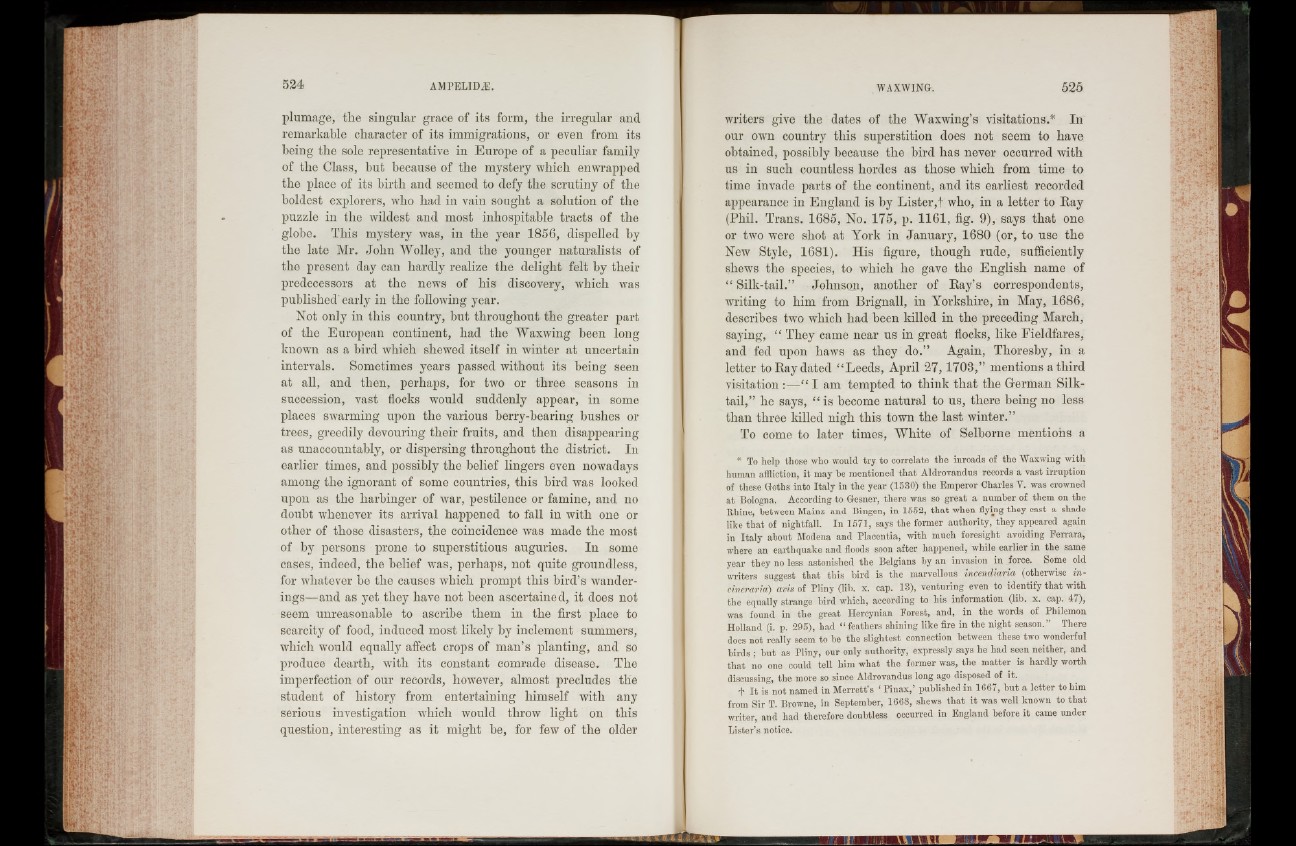
plumage, the singular grace of its form, the irregular and
remarkable character of its immigrations, or even from its
being the sole representative in Europe of a peculiar family
of the Class, but because of the mystery which enwrapped
the place of its birth and seemed to defy the scrutiny of the
boldest explorers, who had in vain sought a solution of the
puzzle in the wildest and most inhospitable tracts of the
glohe. This mystery was, in the year 1856, dispelled by
the late Mr. John Wolley, and the younger naturalists of
the present day can hardly realize the delight felt by their
predecessors at the news of his discovery, which was
published'early in the following year.
Not only in this country, but throughout the greater part
of the European continent, had the Waxwing been long
known as a bird which shewed itself in winter at uncertain
intervals. Sometimes years passed without its being seen
at all, and then, perhaps, for two or three seasons in
succession, vast flocks would suddenly appear, in some
places swarming upon the various berry-bearing bushes or
trees, greedily devouring their fruits, and then disappearing
as unaccountably, or dispersing throughout the district. In
earlier times, and possibly the belief lingers even nowadays
among the ignorant of some countries, this bird was looked
upon as the harbinger of war, pestilence or famine, and no
doubt whenever its arrival happened to fall in with one or
other of those disasters, the coincidence was made the most
of by persons prone to superstitious auguries. In some
cases, indeed, the belief was, perhaps, not quite groundless,
for whatever be the causes which prompt this bird’s wanderings—
and as yet they have not been ascertained, it does not
seem unreasonable to ascribe them in the first place to
scarcity of food, induced most likely by inclement summers,
which would equally affect crops of man’s planting, and so
produce dearth, with its constant comrade disease. The
imperfection of our records, however, almost precludes the
student of history from entertaining himself with any
serious investigation which would throw light on this
question, interesting as it might be, for few of the older
writers give the dates of the Waxwing’s visitations.* In
our own country this superstition does not seem to have
obtained, possibly because the bird has never occurred with
us in such countless hordes as those which from time to
time invade parts of the continent, and its earliest recorded
appearance in England is by Lister,! who, in a letter to Ray
(Phil. Trans. 1685, No. 175, p. 1161, fig. 9), says that one
or two were shot at York in January, 1680 (or, to use the
New Style, 1681). His figure, though rude, sufficiently
shews the species, to which he gave the English name of
“ Silk-tail.” Johnson, another of Ray’s correspondents,
writing to him from Brignall, in Yorkshire, in May, 1686,
describes two which had been killed in the preceding March,
saying, “ They came near us in great flocks, like Fieldfares,
and fed upon haws as they do.” Again, Thoreshy, in a
letter to Ray dated “ Leeds, April 27,1703,” mentions a third
visitation :—“ I am tempted to think that the German Silk-
tail,” he says, “ is become natural to us, there being no less
than three killed nigh this town the last winter.”
To come to later times, White of Selhorne mentions a
* To help those who would try to correlate the inroads of the Waxwing with
human affliction, it may he mentioned that Aldrovandus records a vast irruption
of these Goths into Italy in the year (1530) the Emperor Charles Y. was crowned
at Bologna. According to Gesner, there was so great a number of them on the
Rhine, between Mainz and Bingen, in 1552, th a t when flying they cast a shade
like that of nightfall. In 1571, says the former authority, they appeared again
in Italy about Modena and Placentia, with much foresight avoiding Ferrara,
where an earthquake and floods soon after happened, while earlier in the same
year they no less astonished the Belgians by an invasion in force. Some old
writers suggest that this bird is the marvellous incendiaria (otherwise in-
cineraria) avis of Pliny (lib. x. cap. 13), venturing even to identify that with
the equally strange bird which, according to his information (lib. x. cap. 47),
was found in the great Hercynian Forest, and, in the words of Philemon
Holland (i. p. 295), had “ feathers shining like fire in the night season.” There
does not really seem to be the slightest connection between these two wonderful
birds ; but as Pliny, our only authority, expressly says he had seen neither, and
that no one could tell him what the former was, the matter is hardly worth
discussing, the more so since Aldrovandus long ago disposed of it.
+ I t is not named in Merrett’s ‘ Pinax,’ published in 1667, but a letter to him
from Sir T. Browne, in September, 1668, shews that it was well known to that
writer, and had therefore doubtless occurred in England before it came under
Lister’s notice.